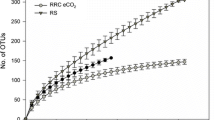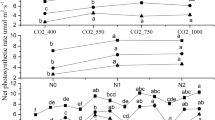Abstract
Global atmospheric CO2 levels are expected to double within the next 50 years. To assess the effects of increased atmospheric CO2 on soil ecosystems, cloned trembling aspen (Populus tremuloides) seedlings were grown individually in 1 m3 open bottom root boxes under either elevated (720 ppm, ELEV) or ambient CO2 (360 ppm, AMB). After 5 years, soil cores (40 cm depth) were collected from the root boxes and divided into 0–20 cm and 20–40 cm fractions. ELEV treatment resulted in significant decreases in both soil nitrate and total soil nitrogen in both the 0–20 cm and 20–40 cm soil fractions, with a 47% decrease in soil nitrate and a 50% decrease in total soil nitrogen occurring in the 0–20 cm fraction. ELEV treatment did not result in a significant change in the amount of soil microbial biomass. However, analysis of indicator phospholipid fatty acids (PLFA) indicated that ELEV treatment did result in significant increases in PLFA indicators for fungi and Gram-negative bacteria in the 0–20 cm fraction. Terminal restriction fragment length polymorphism (T-RFLP) analysis was used to analyze the composition of the soil bacterial communities (using primers targeting the 16SrRNA gene) and the soil fungal communities (using primers targeting the intergenic transcribed spacer region). T-RFLP analysis revealed shifts in both bacterial and fungal community structure, as well as increases in both bacterial and fungal species richness with ELEV treatment. These results indicated that increased atmospheric CO2 had significant effects on both soil nutrient availability and the community composition of soil microbes associated with aspen roots.





Similar content being viewed by others
Reference
Ball AS, Drake BG (1997) Short-term decomposition of litter produced by plants grown in ambient and elevated atmospheric CO2 concentrations. Glob Change Biol 3: 29–35
Bear FE (1955) Chemistry of the Soil. Reinhold Publishing Co., New York
Cardon ZG, Hungate BA, Cambardella CA (2001) Contrasting effects of elevated CO2 on old and new soil carbon pools. Soil Biol Biochem 33: 365–373
Coleman DC, Andrews R, Ellis JE, Singh JS (1976). Energy-flow and partitioning in selected man-managed and natural ecosystems. Agro-Ecosystems 3: 45–54
Cotrufo MF, Ineson P (1996) Elevated CO2 reduces field decomposition rates of Betula pendula (Roth) leaf litter. Oecologia 106: 525–530
Curtis PS, Teeri JA (1992). Seasonal responses of leaf gas-exchange to elevated carbon-dioxide in Populus grandidentata. Can J For Res 22: 1320–1325
Curtis PS, Zak DR, Pregitzer KS, Lussenhop J, Teeri JA (1996) Linking above-ground and below-ground responses to rising CO2 in northern deciduous forest species. In: Koch GW, Mooney HA (Eds) carbon dioxide and terrestrial ecosystems. Academic Press, San Diego,CA, pp 41–51
De Angelis P, Chigwerewe KS, Mugnozza GES (2000) Litter quality and decomposition in an CO2-enriched Mediterranean forest ecosystem. Plant Soil 224: 31–41
Dhillion SS, Roy J, Abrams M (1996) Assessing the impact of elevated CO2 on soil microbial activity in a Mediterranean model ecosystem. Plant Soil 187: 333–342
Environmental Protection Agency (1993) Methods for the Determination of Inorganic Substances in Environmental Samples. EPA/600/R-93/100
Environmental Protection Agency (1996) Test Methods for Evaluating Solid Waste: Physical/Chemical Methods. EPA SW-846, Chapter 3
Frank K, Beegle D, Denning, J (1998) Phosphorus. In: Brown, JR (Ed.) Recommended Chemical Soil Test Procedures for the North Central Region. University of Missouri-Columbia, Columbia, MO, pp 21–30
Frostegard A, Tunlid A, Baath E (1991) Microbial biomass measured as total lipid phosphate in soils of different organic content. J Microbiol Meth 14: 151–163
Gardes M, Bruns TD (1993) ITS primers with enhanced specificity for basidiomycetes—application to the identification of mycorrhizae and rusts. Mol Ecol 2: 113–118
Gardner WH (1986) Water Content. In: Klute A (Ed). Methods of Soil Analysis, Part I. Soil Science Society of America. Madison WI, pp 493–544
Gelderman RH, Beegle, D (1998) Nitrate-nitrogen. In: Brown, JR (Ed.) Recommended Chemical Soil Test Procedures for the North Central Region. University of Missouri-Columbia, Columbia, MO, pp 17–20
Grayston SJ, Campbell CD, Lutze JL, Gifford RM (1998) Impact of elevated C02 on the metabolic diversity of microbial communities in N-limited grass swards. Plant Soil 203: 289–300
Guckert JB, Antworth CP, Nichols PD, White DC (1985) Phospholipid, ester-linked fatty acid profiles as reproducible assays for changes in prokaryotic community structure of estuarine sediments. FEMS Microbiol Ecol 31: 147–158
Hu S, Chapin FS, Firestone MK, Field CB, Chiarello NR (2001) Nitrogen limitation of microbial decomposition in a grassland under elevated CO2. Nature 409: 188–191
Hungate BA, Holland EA, Jackson RB, Chapin FS, Mooneyk HA, Field CB (1997) The fate of carbon in grasslands under carbon dioxide enrichment. Nature 388: 576–579
Insam H, Baath E, Berreck M, Frostegard A, Gerzabek MH, Kraft A, Schinner F, Schweiger P, Tschuggnall G (1999) Responses of the soil microbiota to elevated CO2 in an artificial tropical ecosystem. J Microbiol Meth 36: 45–54
Kandeler E, Tscherko D, Bardgett RD, Hobbs PJ, Kampichler C, Jones TH (1998) The response of soil microorganisms and roots to elevated CO2 and temperature in a terrestrial model ecosystem. Plant Soil 202: 251–262
Keeling, CD, Whort, TP (1999) Atmospheric CO2 records from sites in the SIO air sampling network. In: Trends: Compendium of Data on Global Change. Carbon Dioxide Information Analysis Center, Oak Ridge National Laboratory, US Department of Energy, Oak Ridge, TN
Kennedy AC, Smith KL (1995) Soil microbial diversity and the sustainability of agricultural soils. Plant Soil 170: 77–86
Kelly JJ, Haggblom M, Tate RL (1999) Changes in soil microbial communities over time resulting from one time application of zinc: a laboratory microcosm study. Soil Biol Biochem 31: 1455–1465
Klamer M, Roberts MS, Levine LH, Drake BG, Garland JL (2002) Influence of elevated CO2 on the fungal community in a coastal scrub oak forest soil investigated with terminal-restriction fragment length polymorphism analysis. Appl Environ Microbiol 68: 4370–4376
Koizumi H, Nakada T, Usami Y, Satoh M, Shiyomi M, Oikawa T (1991) Effect of carbon dioxide concentration on microbial respiration in soil. Ecol Res 6: 227–232
Konopka A, Zakharova T, Bischoff M, Oliver L, Nakatsu C, Turco RF (1999) Microbial biomass and activity in lead-contaminated soil. Appl Environ Microbiol 65: 256–2259
Liu W, Marsh TL, Cheng H, Forney LJ (1997) Characterization of microbial diversity by determining terminal restriction fragment length polymorphisms of genes encoding 16S rRNA. Appl Environ Microbiol 63: 4516–4522
Lussenhop J, Treonis A, Curtis PS, Teeri JA, Vogl CS (1998) Response of soil biota to elevated atmospheric CO2 in poplar model systems. Oecologia 113: 247–251
MIDI (1995) Sherlock Microbial Identification System Operating Manual: Version 5. MIDI Inc., Newark, DE
Mikan CJ, Zak DR, Kubisker ME, Pregitzer KS (2000) Combined effects of atmospheric CO2 and N availability on the belowground carbon and nitrogen dynamics of aspen mesocosms. Oecologia 124: 432–445
Niklaus PA, Kandeler E, Leadley PW, Schmid B, Tscherko D, Korner C (2001) A link between plant diversity, elevated CO2, and soil nitrate. Oecologia 127: 540–548
O’Neill EG, Luxmoore RJ, Norby RJ (1987) Increases in mycorrhizal colonization and seedling growth in Pinus echinata and Quercus alba in an enriched CO2 atmosphere. Can J For Res 17: 878–883
Norby RJ, O’Neill EG, Hood WG, Luxmoore RJ (1987) Carbon allocation, root exudation, and mycorrhizal colonization of Pinus echinata seedlings grown under CO2 enrichment. Tree Physiol 3: 203–210
Pennanen T (2001) Microbial communities in boreal coniferous forest humus exposed to heavy metals and changes in soil pH — a summary of the use of phospholipid fatty acids. Biolog and H-3-thymidine incorporation methods in field studies. Geoderma 100: 91–126
Rice CW, Garcia FO, Hampton CO, Owensby CE (1994) Soil microbial response in tallgrass prairie to elevated CO2. Plant Soil 165: 67–74
Rier ST, Tuchman NC, Wetzel RG, Teeri JA (2002) Elevated-CO2-induced changes in the chemistry of quaking aspen (Populus tremuloides Michaux) leaf litter: subsequent mass loss and microbial response in a stream ecosystem. J North Am Benthol Soc 21: 16–27
Sadowsky MJ, Shortemeyer M (1997) Soil microbial responses to increased concentrations of atmospheric CO2. Glob Change Biol 3: 217–224
Schmidt, TL, Spencer, JS, Bertsch, R (1993) Michigan’s forests 1993: an analysis. U.S. Department of Agriculture, Forest Service, North Central Experiment Station. Resource Bulletin NC-179
Strain BR, Bazaaz FA (1983) Terrestrial plant communities. In: Lemon EH (Ed). The Response of Plants to Rising Levels of Atmospheric Carbon Dioxide AAAS Selected Symposium 8), Washington, DC, pp 117–222
Tate RL (1995) Soil Microbiology. John Wiley and Sons, Inc. New York
Thomas, GW (1996) Soil ph and soil acidity. In: Sparks, D (Ed.) Methods of Soil Analysis. Part II. Soil Science Society of America, Madison, WI
Tuchman NC, Wahtera KA, Wetzel RG, Russo NM, Kilbane GM, Sasso LM, Teeri JA (2003) Nutritional quality of leaf detritus altered by elevated atmospheric CO2: effects on development of mosquito larvae. Freshwater Biol 48: 1432–1439
Tuchman NC, Wahtera KA, Wetzel RG, Teeri JA (2003) Elevated atmospheric CO2 alters leaf litter quality for stream ecosystems: an in-situ leaf decomposition study. Hydrobiology 495: 203–211
Tuchman NC, Wetzel RG, Rier ST, Wahtera KA, Teeri JA (2002) Elevated atmospheric CO2 lowers leaf litter nutritional quality for stream ecosystem food webs. Global Change Biol 8: 145–153
van Ginkel JH, Gorissen A, Polci D (2000) Elevated atmospheric carbon dioxide concentration: effects of increased carbon input in a Lolium perenne soil on microorganisms and decomposition. Soil Biol Biochem 32: 449–456
Vitousek PM, Howarth RW (1991) Nitrogen limitation on land and in the sea: how can it occur? Biogeochemistry 13: 87–115
Wagner GH, Wolf DC (1999) Carbon transformation and soil organic matter formation. In: Sylvia DM, Fuhrmann JJ, Hartel PG, Zuberer DA (Eds). Principles and Applications of Soil Microbiology. Prentice-Hall. Upper Saddle River, NJ
Watson RT, Miera-Filho LG, Sanjueza E, Janetos A (1992) Greenhouse gases: sources and sinks. In: Houghton JT, Callander BA, Varney SK (Eds). Climate Change 1992: The Supplementary Report to the IPCC Scientific Assessment, Cambridge, University Press, Cambridge, UK, pp 25–46
Wetzel RG, Grace JB (1983) Atmospheric CO2 enrichment effects on aquatic plants. In: Lemon EH (Ed). The Response of Plants to Rising Levels of Atmospheric Carbon Dioxide. American Association for the Advancement of Science, Washington, DC, pp 223–280
White DC, Davis WM, Nickels JS, King JD, Bobbie RJ (1979) Determination of the sedimentary microbial biomass by extractable lipid phosphate. Oecologia 40: 51–62
Wiemken, Laczko E, Ineichen K, Boller T (2001) Effects of elevated carbon dioxide and nitrogen fertilization on mycorrhizal fine roots and the soil microbial community in beech-spruce ecosystems on siliceous and calcareous soil. Microb Ecol 42: 126–135
Zak DR, Pregitzer KS, Curtis PS, Holmes WE (2000) Atmospheric CO2 and the composition and function of soil microbial communities. Ecol Appl 10: 47–59
Zak DR, Ringelberg DB, Pregitzer KS, Randlett DL, White DC, Curtis PS (1996) Soil microbial communities beneath Populus grandidentata grown under elevated atmospheric CO2. Ecol Appl 6: 257–262
Zak DR, Pregitzer KS, Curtis PS, Teeri JA, Fogel R, Randlett DL (1993) Elevated atmospheric CO2 and feedbacks between carbon and nitrogen cycles. Plant Soil 151: 105–117
Acknowledgments
Soil analyzed in this project were collected at the Elevated CO2 Research Facility of the University of Michigan Biological Station, where infrastructural support was provided by the U.S. DOE National Institute of Global Environmental Change (NIGEC). This research was supported, in part, by grants awarded to N.C.T. from the National Science Foundation (DEB-9903888 and DEB-0108847) and by a supplement to grant DEB-0108847 awarded to N.C.T. and J.J.K. from the National Science Foundation. The authors thank M. J. Kirisits for assistance with the T-RFLP technique, M. Haggblom for use of the MIDI system, M. Parsek for generously providing the Pseudomonas aeruginosa culture, and L. Edgerton-Warburton for generously providing the Cortinarius multiformis tissue.
Author information
Authors and Affiliations
Corresponding author
Rights and permissions
About this article
Cite this article
Janus, L.R., Angeloni, N.L., McCormack, J. et al. Elevated Atmospheric CO2 Alters Soil Microbial Communities Associated with Trembling Aspen (Populus tremuloides) Roots. Microb Ecol 50, 102–109 (2005). https://doi.org/10.1007/s00248-004-0120-9
Received:
Accepted:
Published:
Issue Date:
DOI: https://doi.org/10.1007/s00248-004-0120-9




